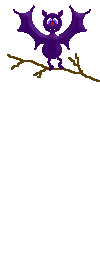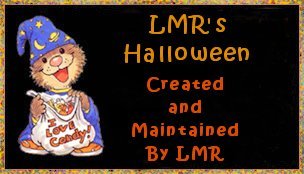Welcome to LMR's Happy Halloween Page! Please, don't be too frightened. I have Igor locked away right now. He will not harm you. As for the monsters, ghosts, ghouls and goblins that have made their home here, that is a different story! They come and go as they please.
The experiments I am conducting in my laboratory should not concern you, unless of course you are a good candidate for those experiments!
MMWHAA HAA HAA! Let me tell you about the site before I scare you away.
The site includes the history of Halloween, the Jack O'Lantern, Dracula, Vlad The Impaler and vampires. I listed various web sites that I used to design the site. There are movie listings for the month (TV and theater), recipes, Halloween graphics, cards, midis, cheesy Halloween jokes and a few of my favorite sites. Hopefully, something on the site will interest you.
A fellow Halloween fiend, I mean friend mmmwhhhaaa haaa haaa, has found a home for his Halloween graphics here. You may want to check them out.... that is if you are not afraid to look ! Thank you ford-dad ! ENJOY!


THE STORY OF HALLOWEEN
Ancient Origins
Halloween is one of the oldest holidays with origins going back thousands of years. The holiday we know as Halloween has had many influences from many cultures over the centuries. From the Roman's Pomona Day, to the Celtic festival of Samhain, to the Christian holidays of All Saints and All Souls Days.
Hundreds of years ago in what is now Great Britain and Northern France, lived the Celts. The Celts worshipped nature and had many gods, with the sun god as their favorite. It was "he" who commanded their work and their rest times, and who made the earth beautiful and the crops grow.
The Celts celebrated their New Year on November 1st. It was celebrated every year with a festival and marked the end of the "season of the sun" and the beginning of "the season of darkness and cold."
The Celts believed, that during the winter, the sun god was taken prisoner by Samhain, the Lord of the Dead and Prince of Darkness. Samhain is also spelled SAMAIN (Celtic: "End of Summer"), one of the most important and sinister calendar festivals of the Celtic year. At Samhain, held on November 1, the world of the gods was believed to be made visible to mankind, and the gods played many tricks on their mortal worshipers; it was a time fraught with danger, charged with fear, and full of supernatural episodes. Sacrifices and propitiations of every kind were thought to be vital, for without them the Celts believed they could not prevail over the perils of the season or counteract the activities of the deities.
On the eve before their new year (October 31), it was believed that Samhain called together all the dead people. The dead would take different forms, with the bad spirits taking the form of animals. The most evil taking the form of cats.
On October 31st after the crops were all harvested and stored for the long winter the cooking fires in the homes would be extinguished. The Druids, the Celtic priests, would meet in the hilltop in the dark oak forest (oak trees were considered sacred). The Druids would light new fires and offer sacrifices of crops and animals. As they danced around the the fires, the season of the sun passed and the season of darkness would begin.
When the morning arrived the Druids would give an ember from their fires to each family who would then take them home to start new cooking fires. These fires would keep the homes warm and free from evil spirits.
The November 1st festival was named after Samhain and honored both the sun god and Samhain. The festival would last for 3 days. Many people would parade in costumes made from the skins and heads of their animals. This festival would become the first Halloween.
During the first century the Romans invaded Britain. They brought with them many of their festivals and customs. In those countries that once belonged to the Roman Empire there is the custom of eating or giving away fruit, especially apples, on Halloween. It spread to neighbouring countries: to Ireland and Scotland from Britain, and to the Slavic countries from Austria. It is probably based upon a celebration of the Roman goddess Pomona, to whom gardens and orchards were dedicated. Since the annual Feast of Pomona was held on November 1, the relics of that observance became part of our Halloween celebration, for instance the familiar tradition of "bobbing" for apples.
By the 800s, the influence of Christianity had spread into Celtic lands. In the seventh century, Pope Boniface IV designated November 1 All Saints' Day, a time to honor saints and martyrs. It is widely believed today that the pope was attempting to replace the Celtic festival of the dead with a related, but church-sanctioned holiday. The celebration was also called All-hallows or All-hallowmas (from Middle English Alholowmesse meaning All Saints' Day) and the night before it, the night of Samhain, began to be called All-hallows Eve and, eventually, Halloween. Even later, in A.D. 1000, the church would make November 2 All Souls' Day, a day to honor the dead. It was celebrated similarly to Samhain, with big bonfires, parades, and dressing up in costumes as saints, angels, and devils. Together, the three celebrations, the eve of All Saints', All Saints', and All Souls', were called Hallowmas.
The Halloween we celebrate today includes all of these influences, Pomona Day's apples, nuts, and harvest, the Festival of Sanhain's black cats, magic, evil spirits and death, and the ghosts, skeletons and skulls from All Saint's Day and All Soul's Day.
Modern Traditions
The American tradition of "trick-or-treating" probably dates back to the early All Souls' Day parades in England. During the festivities, poor citizens would beg for food and families would give them pastries called "soul cakes" in return for their promise to pray for the family's dead relatives. The distribution of soul cakes was encouraged by the church as a way to replace the ancient practice of leaving food and wine for roaming spirits. The practice, which was referred to as "going a-souling" was eventually taken up by children who would visit the houses in their neighborhood and be given ale, food, and money.
The tradition of dressing in costume for Halloween has both European and Celtic roots. Hundreds of years ago, winter was an uncertain and frightening time. Food supplies often ran low and, for the many people afraid of the dark, the short days of winter were full of constant worry. On Halloween, when it was believed that ghosts came back to the earthly world, people thought that they would encounter ghosts if they left their homes. To avoid being recognized by these ghosts, people would wear masks when they left their homes after dark so that the ghosts would mistake them for fellow spirits. On Halloween, to keep ghosts away from their houses, people would place bowls of food outside their homes to appease the ghosts and prevent them from attempting to enter.
Evolution Of A Holiday
As European immigrants came to America, they brought their varied Halloween customs with them. Because of the rigid Protestant belief systems that characterized early New England, celebration of Halloween in colonial times was extremely limited there. It was much more common in Maryland and the southern colonies. As the beliefs and customs of different European ethnic groups, as well as the American Indians, meshed, a distinctly American version of Halloween began to emerge. The first celebrations included "play parties," public events held to celebrate the harvest, where neighbors would share stories of the dead, tell each other's fortunes, dance, and sing. Colonial Halloween festivities also featured the telling of ghost stories and mischief-making of all kinds. By the middle of the nineteenth century, annual autumn festivities were common, but Halloween was not yet celebrated everywhere in the country.
In the second half of the nineteenth century, America was flooded with new immigrants. These new immigrants, especially the millions of Irish fleeing Ireland's potato famine of 1846, helped to popularize the celebration of Halloween nationally. Taking from Irish and English traditions, Americans began to dress up in costumes and go house to house asking for food or money, a practice that eventually became today's "trick-or-treat" tradition. Young women believed that, on Halloween, they could divine the name or appearance of their future husband by doing tricks with yarn, apple parings, or mirrors.
In the late 1800s, there was a move in America to mold Halloween into a holiday more about community and neighborly get-togethers, than about ghosts, pranks, and witchcraft. At the turn of the century, Halloween parties for both children and adults became the most common way to celebrate the day. Parties focused on games, foods of the season, and festive costumes. Parents were encouraged by newspapers and community leaders to take anything "frightening" or "grotesque" out of Halloween celebrations. Because of their efforts, Halloween lost most of its superstitious and religious overtones by the beginning of the twentieth century.
By the 1920s and 1930s, Halloween had become a secular, but community-centered holiday, with parades and town-wide parties as the featured entertainment. Despite the best efforts of many schools and communities, vandalism began to plague Halloween celebrations in many communities during this time. By the 1950s, town leaders had successfully limited vandalism and Halloween had evolved into a holiday directed mainly at the young. Due to the high numbers of young children during the fifties baby boom, parties moved from town civic centers into the classroom or home, where they could be more easily accommodated. Between 1920 and 1950, the centuries-old practice of trick-or-treating was also revived. Trick-or-treating was a relatively inexpensive way for an entire community to share the Halloween celebration. In theory, families could also prevent tricks being played on them by providing the neighborhood children with small treats. A new American tradition was born, and it has continued to grow. Today, Americans spend $2.5 billion annually on Halloween, making it the country's second largest commercial holiday.

 More This Way...Various Web Pages
More This Way...Various Web Pages
